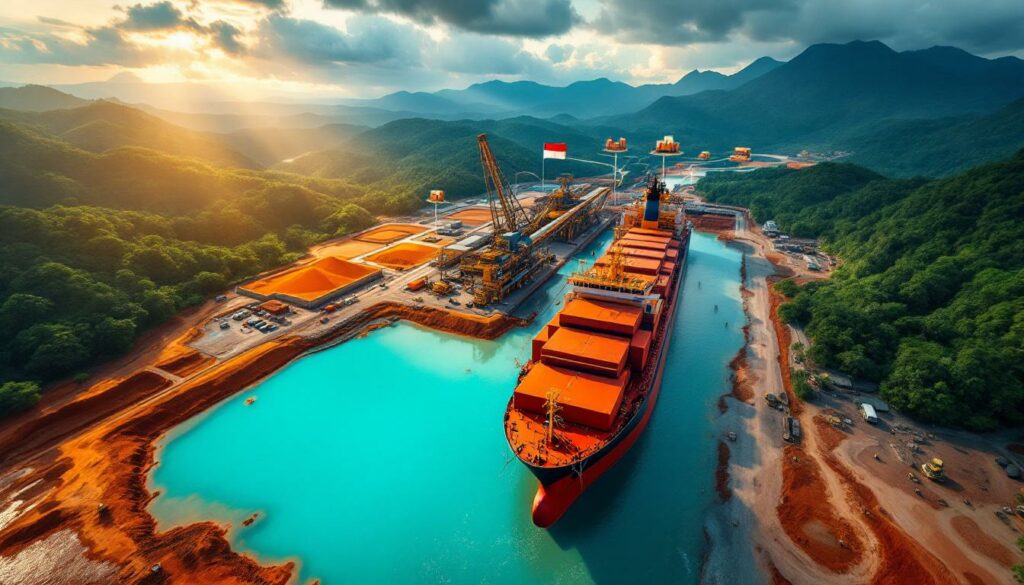What Has Happened at First Quantum's Panama Copper Mine?
First Quantum Minerals has begun shipping stockpiled copper concentrate from its Cobre Panama mine, marking a pivotal development after 19 months of operational shutdown. The resumption of shipments began on June 18, 2025, when the bulk carrier Lipsi departed from Punto Rincon, First Quantum's private port facility in Panama. This vessel, with approximately 35,000 deadweight tons of cargo capacity, is transporting copper concentrate to European copper smelter Aurubis AG.
The milestone shipment comes after nearly two years of complex negotiations and legal challenges that have tested both First Quantum and Panama's mining regulatory framework. Industry observers note that while this development doesn't signal a restart of mining operations, it represents a potential thawing in relations between the company and Panamanian authorities.
The Unexpected Shutdown and Recent Developments
The Cobre Panama mine's operations were abruptly halted following a November 2023 ruling by Panama's Supreme Court, which declared First Quantum's mining license unconstitutional. The court's decision cited both procedural irregularities in how the license was granted and significant environmental concerns related to the mine's operations in Panama's biodiverse rainforest region.
"The unexpected closure of Cobre Panama sent shock waves through the industry," noted Bloomberg in their analysis of the situation, highlighting the widespread impact of the shutdown beyond just First Quantum's operations.
After months of negotiations and diplomatic efforts, the Panamanian government recently authorized the company to export approximately 120,000 tons of copper concentrate that had remained stockpiled at the site since the shutdown. This authorization represents a potential turning point in the ongoing situation, though full resolution remains distant.
The Legal Battle and Government Authorization
The legal challenges that led to Cobre Panama's closure were multifaceted, involving constitutional questions about foreign ownership of natural resources, environmental compliance issues, and disputes over royalty rates. The Supreme Court's ruling effectively nullified a contract that would have allowed the mine to operate for decades, creating significant uncertainty for both First Quantum and Panama's mining sector.
The recent export authorization required careful navigation of these legal constraints. Panama's government had to create a special provision that allowed for the movement of already-extracted material while maintaining the prohibition on new mining activities. This nuanced approach reflects the government's attempt to balance economic considerations with legal compliance and environmental protection.
How Will These Shipments Impact the Global Copper Market?
The release of Cobre Panama's stockpiled concentrate into the global market comes at a critical moment for copper supply chains worldwide. While the 120,000 tons represents only a fraction of what the mine would produce during normal operations, the timing of these shipments has outsized significance in the current tight market conditions.
Market analysts predict these shipments will provide temporary price stability but emphasize that the fundamental supply shortage remains unresolved without full production resumption. The market has already priced in some expectation of these stockpiled shipments, limiting their long-term price impact.
Relief for Copper Smelters Amid Supply Shortages
Since Cobre Panama's closure in late 2023, copper smelters worldwide have faced unprecedented concentrate shortages. Processing fees—known as treatment and refining charges (TC/RCs)—have plunged to historic lows, signaling a severe shortage of copper ore. These fees, normally paid by miners to smelters for processing concentrate into refined metal, serve as a key indicator of copper ore availability in the market.
The supply constraints have had devastating effects on global smelting operations. Multiple facilities in the Philippines and Namibia have been forced to completely cease operations due to lack of concentrate supply. Many other smelters across Asia and Europe have reduced production capacity, operating well below their technical capabilities despite rising copper demand.
The Ripple Effect on Global Copper Supply
Cobre Panama's shutdown removed approximately 1.5% of global copper output from the market—a significant amount in an already tight supply environment. Industry experts note that this loss was particularly impactful because it coincided with expansion in global smelting capacity, creating a perfect storm of supply chain pressures.
"The release of Cobre Panama's inventory provides temporary relief during a period of worsening copper supply imbalance," according to industry analysts monitoring the situation.
The resumption of shipments from stockpiled material may provide momentary easing to smelters desperate for raw materials, though it doesn't represent a return to production. The 120,000 tons being released will help bridge immediate gaps but represents less than 10% of what the mine would produce annually at full capacity.
What Are First Quantum's Plans for the Stockpiled Copper?
First Quantum has implemented a strategic, phased approach to distributing its remaining copper concentrate inventory. The company faces both financial imperatives and operational challenges as it manages the complex situation in Panama, with the stockpiled material representing a significant asset on its balance sheet.
The careful planning of these shipments reflects both market considerations and the company's need to maintain positive relations with various stakeholders, including offtake partners who have contracts predating the mine's closure.
Distribution Strategy for Remaining Inventory
Following the initial shipment to Aurubis AG, First Quantum plans to distribute the remaining stockpiled concentrate to offtake partners in Japan and South Korea over the coming months. This phased approach allows the company to fulfill existing contractual obligations while maximizing the value of the stored material.
The company has not disclosed the exact allocation between these Asian partners, but industry sources indicate the distribution will be guided by pre-existing supply agreements. These longstanding partnerships with Asian smelters have proven crucial during this challenging period, with many maintaining their relationship with First Quantum despite the production interruption.
Financial Implications for Mine Maintenance
Revenue generated from these copper concentrate sales will be crucial for funding the maintenance of the idle Cobre Panama operation. First Quantum faces substantial monthly costs—estimated at approximately $20 million—to maintain the site in a condition that would allow for potential future restart.
"Revenues from the sales will be used to fund maintenance while First Quantum lobbies for resumption," Bloomberg reported, highlighting the financial strategy behind these shipments.
These maintenance activities include essential environmental management systems, security operations, and preservation of critical infrastructure. Without this ongoing investment, the site would deteriorate rapidly in Panama's tropical climate, potentially creating both environmental issues and making any eventual restart prohibitively expensive.
The maintenance costs represent a significant financial burden that has strained First Quantum's balance sheet since the forced shutdown. While the company has implemented cost-cutting measures across its global operations, the ongoing expenses at Cobre Panama have been unavoidable if the company wishes to preserve the possibility of future operations.
Is There Hope for Restarting Cobre Panama Operations?
The question of whether Cobre Panama will ever resume operations remains central to both First Quantum's future and Panama's mining sector. The situation involves complex interplay between political, legal, economic, and social factors, with multiple stakeholders influencing the potential path forward.
Recent diplomatic exchanges have offered cautious optimism, though significant obstacles remain before any mining activities could legally resume at the site. Both sides appear to recognize the potential mutual benefits of resolution, while acknowledging the need for fundamental changes to the previous arrangement.
Current Political Climate and Negotiation Status
Panamanian President José Raúl Mulino recently indicated that conditions are becoming more favorable to begin substantive discussions about potentially restarting the mine. However, he cautioned that significant hurdles remain before any agreement can be reached, particularly regarding constitutional compliance and environmental safeguards.
First Quantum continues to actively lobby for resumption of operations, maintaining what BMO Capital Markets analysts describe as a "positive and patient" approach to negotiations. This strategy reflects the company's recognition that a resolution will require time and flexibility, particularly given the constitutional issues at stake.
The company has established dedicated teams focused on stakeholder engagement, including government relations, community outreach, and environmental remediation planning. These efforts signal First Quantum's long-term commitment to finding a path forward in Panama, despite the current operational hiatus.
The Path Forward: Challenges and Opportunities
Restarting operations at Cobre Panama would require addressing several fundamental challenges. First, any new agreement would need to comply with Panama's constitutional provisions regarding natural resource exploitation. Second, environmental concerns that contributed to public opposition must be substantively addressed through enhanced protections and monitoring.
The process is further complicated by planned referendums on mining contracts and ongoing environmental activism. Panama's government has indicated that any future mining agreements may require direct public approval through democratic processes, adding another layer of complexity to potential negotiations.
Any restart would likely involve significant changes to the original operating agreement, potentially including increased royalty rates, stricter environmental controls, greater local ownership participation, and enhanced community benefit provisions. Industry analysts suggest that First Quantum may need to accept considerably less favorable terms than its previous contract to secure operational rights.
How Has the Closure Affected Panama's Economy and First Quantum's Position?
The 19-month closure of Cobre Panama has created ripple effects throughout Panama's economy and severely impacted First Quantum's financial position. What began as a legal and regulatory dispute has evolved into a multifaceted economic challenge with implications for national development, local communities, and global mining investment patterns.
The prolonged nature of the shutdown has magnified its impact, with both immediate consequences and longer-term structural changes to Panama's development trajectory and First Quantum's corporate strategy.
Economic Impact on Panama
The closure of Cobre Panama has had substantial economic consequences for the country, which previously benefited significantly from royalties, taxes, and employment opportunities generated by the mine. Prior to the shutdown, the operation contributed approximately 1.5% to Panama's GDP and represented one of the country's largest sources of export earnings.
The economic fallout extends beyond direct revenue losses. Thousands of jobs have been affected, including both direct mine employees and workers in supporting industries and services. Local businesses that had developed around the mining operation have experienced sharp declines in revenue, creating economic hardship in communities that had become dependent on the mine's presence.
This economic impact has contributed to growing pressure for resolution. Local communities that depended on the mine have organized rallies supporting its reopening, highlighting the social dimension of what began as a legal and environmental dispute. These community-led demonstrations illustrate how the mine's economic benefits had created constituencies with a direct stake in its continued operation.
First Quantum's Financial and Strategic Position
For First Quantum, the Cobre Panama shutdown has been a major financial blow. The company's share price dropped approximately 40% following the closure announcement and has struggled to recover despite the company's diversified asset portfolio. Cobre Panama represented one of First Quantum's flagship assets and a cornerstone of its growth strategy.
The company has implemented extensive cost-cutting measures and strategic adjustments to manage the impact of losing production from this key asset. These measures have included workforce reductions at other operations, deferral of capital projects, and exploration of potential asset sales to strengthen the balance sheet.
The ability to monetize stockpiled concentrate provides some financial relief, but the company's long-term outlook remains closely tied to the potential resumption of operations. First Quantum has maintained that Cobre Panama remains a world-class asset with significant untapped value, justifying the continued investment in site maintenance despite the uncertain timeline for resolution.
What Does This Mean for Global Copper Supply and Demand?
The Cobre Panama situation has emerged as a case study in the growing challenges facing global copper supply chains. As copper demand accelerates due to energy transition requirements, the industry faces increasing constraints from political, environmental, and social factors that complicate the development and operation of major mining projects.
The implications extend beyond this specific mine, reflecting broader trends that will shape copper markets and prices in the coming decades as electrification drives unprecedented demand for this essential metal.
Short-term Market Implications
The release of 120,000 tons of copper concentrate into the market will provide temporary relief to smelters but represents only a fraction of what Cobre Panama would produce annually at full operation. Market analysts suggest this will have a modest impact on copper price predictions and availability in the short term, with the broader supply deficit continuing to influence market dynamics.
Copper treatment charges—the fees smelters charge miners for processing concentrate—have already shown some response to the anticipated shipments, though they remain well below historical averages. This reflects the market's recognition that while the stockpile release helps, it doesn't resolve the fundamental supply constraints.
The situation underscores how quickly major disruptions can impact global copper production forecast, especially as the industry operates with increasingly thin margins between production and consumption. Even temporary losses of major mines can create disproportionate market effects when they occur in an already tight supply environment.
Long-term Industry Outlook
The Cobre Panama situation highlights the increasing challenges facing copper mining globally, including political risks, environmental concerns, and community relations. As demand for copper continues to grow due to green energy transition and electrification trends, the industry faces significant supply constraints that could limit the pace of global decarbonization efforts.
"The Cobre Panama situation highlights political risks and community relations challenges" facing mining companies operating in jurisdictions with evolving regulatory frameworks, according to market analysts.
The International Energy Agency projects copper demand will grow by approximately 50% by 2040 due to renewable energy infrastructure and electric vehicle production. Meeting this demand will require both expansion of existing mines and development of new projects—precisely the type of activities that face increasing regulatory scrutiny and social license challenges illustrated by the Cobre Panama case.
This supply-demand imbalance creates a paradoxical situation where environmental concerns about mining could potentially slow the very energy transition that aims to address broader environmental challenges. Mining companies, governments, and environmental stakeholders increasingly recognize the need for balanced approaches that enable responsible resource development while protecting ecosystems and respecting community rights.
FAQ: First Quantum's Panama Copper Situation
When did Cobre Panama initially begin operations?
Cobre Panama began producing and shipping copper concentrates in June 2019, representing one of the largest mining investments in Panama's history and a significant addition to global copper supply. The project required approximately $6.7 billion in capital investment and took nearly a decade to develop from initial planning to commercial production. At full capacity, it was designed to process about 85 million tonnes of ore annually.
What led to the mine's closure in 2023?
Panama's Supreme Court ruled in November 2023 that First Quantum's mining license was unconstitutional, following public protests and legal challenges regarding environmental concerns and the terms of the mining agreement. The ruling specifically cited irregularities in how the contract was approved and questions about whether it adequately protected Panama's natural resources and provided fair compensation to the nation.
How much copper did Cobre Panama produce at its peak?
At full operation, Cobre Panama accounted for approximately 1.5% of global copper production, making it a significant contributor to the world's copper supply. The mine was producing at an annualized rate of about 350,000 tonnes of copper before operations were suspended, with plans to expand to over 400,000 tonnes in coming years before the shutdown occurred.
What is copper concentrate and why is it important?
Copper concentrate is a semi-processed form of copper ore that has been enriched through milling and flotation processes. It typically contains 20-30% copper and requires further processing at smelters to produce refined copper for industrial use. Concentrate is the primary form in which copper is traded internationally between mines and smelters, forming a crucial link in the global supply chain for this essential metal.
What options does First Quantum have if operations cannot be restarted?
If permanent restart proves impossible, First Quantum may need to consider options including complete divestment, mothballing the site long-term, or negotiating a managed transfer of assets to the Panamanian government or another operator under new terms. Each scenario presents significant challenges, including potential write-downs of invested capital, ongoing environmental management responsibilities, and complex negotiations with multiple stakeholders.
Key Takeaways from First Quantum's Panama Copper Situation
| Aspect | Details |
|---|---|
| Current Status | Shipping of 120,000 tons of stockpiled copper concentrate has begun |
| First Shipment | Bulk carrier Lipsi departed June 18, 2025, carrying concentrate to Aurubis AG |
| Revenue Purpose | Funds will support maintenance of the mothballed operation |
| Market Impact | Provides temporary relief to copper smelters facing concentrate shortages |
| Global Significance | Cobre Panama previously supplied 1.5% of global copper production |
| Future Prospects | Panamanian President indicates openness to restart discussions |
| Timeline | Mine has been closed for 19 months following November 2023 court ruling |
| Additional Shipments | Remaining concentrate to be shipped to partners in Japan and South Korea |
Further Exploration:
Readers interested in learning more about the Cobre Panama situation can also explore related educational content on MINING.com, which offers ongoing coverage of developments in the global copper industry and First Quantum mine update news.
For investors looking to understand the broader implications, copper investment insights provide valuable context on how similar projects are navigating complex regulatory environments across the globe.
Looking to Profit from Major ASX Mining Discoveries?
Discovery Alert's proprietary Discovery IQ model scans the ASX continuously, instantly notifying subscribers of significant mineral discoveries before the broader market reacts. Discover why historic mining announcements can generate substantial returns by exploring the dedicated discoveries page and position yourself to capitalise on the next major resource discovery.




